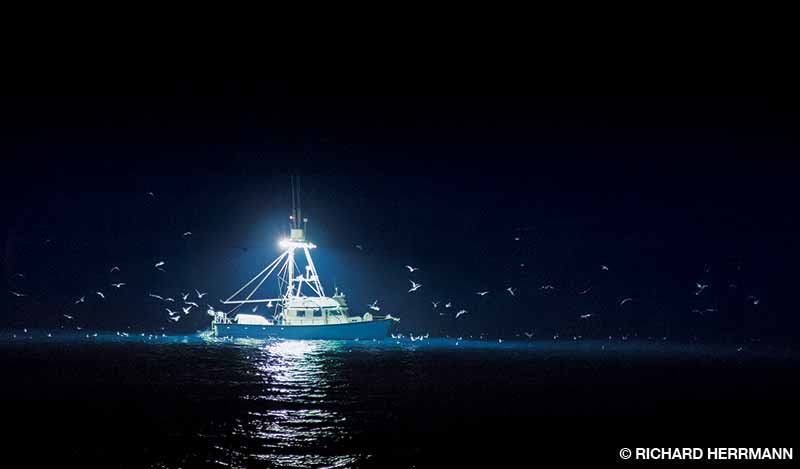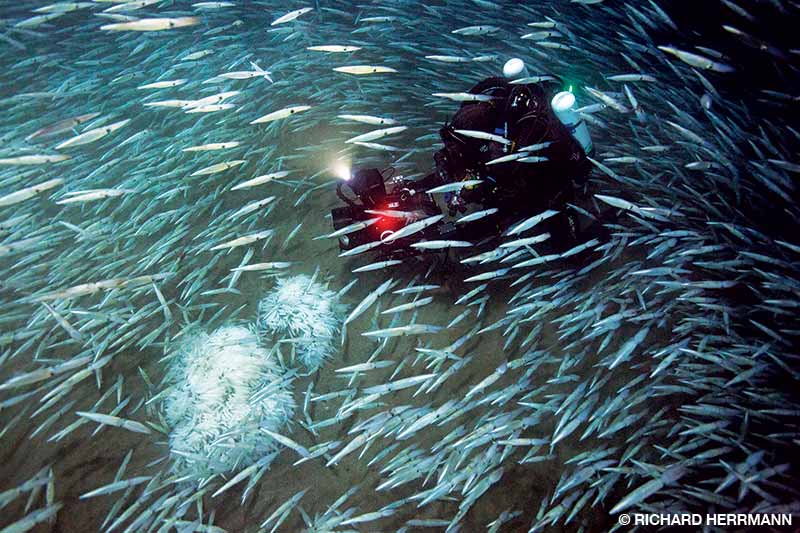As you drop into water as black as night, thousands of pulsating squid in search of mates suddenly surround you. Mating activity is everywhere as multiple males attack single females. The excited squids’ chromatophores (pigment cells) flash colors reminiscent of a Las Vegas neon sign and put you in the middle of a living, moving light show. The action is so frenetic that animals are in your gear and bounce off every inch of your body.
On the sandy bottom, masses of white egg cases form as hundreds of females lay about 20 cases each. Squid can be throughout the water column from the surface to the bottom during a dynamic market squid mating event. The action can be so unorganized and wild that you don’t know where to start or what to shoot.
The California market squid (Doryteuthis opalescens) is a small 8- to 12-inch (20- to 30.5-centimeter) to squid that you can find from Baja California to Alaska. During spawning events, market squid gather by the millions at gently sloping coastal areas and offshore islands and converge on sandy bottoms to lay individual egg capsules containing up to 300 eggs, which the females anchor into the sandy substrate with a sticky substance. The resulting egg masses create beds that can cover acres of the seafloor. The eggs will usually hatch after three to five weeks. After hatching, the tiny paralarvae eat copepods and other zooplankton. Market squid are short-lived, with adults living only six to 10 months. Like most species of shallow-water cephalopods, market squid mature quickly and die right after spawning.

The dynamic spawning runs occur from April to November in Northern California and from October to May in Southern California. The commercial squid fishing industry concentrates its efforts along the California coast, where it generates up to $73 million a year through a well-regulated approach that the California Department of Fish and Wildlife oversees.
Commercial boats use very bright lights at night to attract and concentrate the squid for a form of net fishing called purse seining. Large seiners have lights mounted above the wheelhouse and work in conjunction with small, specialized “light boats” to get the squid to come to the surface so fishers can efficiently net them. When market squid rise to the surface it is called a float. The surface will be thick with thousands of squid that look bright white under the lights during a good float. Film crews and dive boats have success with methods of squid attraction similar to those the fishing industry uses.
Among the theories for why light attracts the squid are that they have an affinity or curiosity for it or the light attracts and illuminates their prey. Whatever the cause, it is proven to work, so film crews and dive boats use the same methods to create squid diving opportunities.

The sportfishing industry sometimes calls market squid “ocean candy” or “candy bait,” because nearly every creature in the ocean wants to eat them. During heavy squid runs, a host of animals come to feed. At night and into the morning hours, birds are everywhere as multiple gull species and cormorants wait for squid to appear near the surface. Just under the surface, sea lions, dolphins and blue sharks gather to chow down. Sea stars, angel sharks, rockfish and other bottom-dwelling animals consume the spawning and dying squid as they reach the seafloor. We saw both bottlenose and common dolphins feeding on the squid at night at the Channel Islands during one film shoot. Although we could only see bottlenose from the boat, the common dolphins would swim through the movie lights to feed. The excited dolphins’ underwater sounds added special effects to a wild scene of what appeared at times as a squid cyclone.
After the squid mating and egg laying are finished, the sandy bottom is quiet again, and the egg cases sway gently back and forth with the surge. This movement helps aerate the eggs as the young squid grow. The white egg cases will swell to about three times the original size and turn a brownish color. A bacteria layer on the outer sheath that is not palatable to fish can protect the eggs from predators until hatching. Some fish and other marine creatures such as sea stars, however, may attack the egg cases. In early 2020, Howard Hall filmed the rarely seen occasion of a green sea turtle eating squid egg cases at Catalina Island.
Divers can access the squid runs from places such as Monterey Bay, the Channel Islands and coastal beaches. The good news is that you can also dive squid spawning events in daylight. After heavy evening spawning events, animals may still be spawning well into late morning on the next day. The morning after a heavy squid run can be impressive. On days with good visibility it can seem like the egg beds go on forever. Among the expanse of bright-white egg cases, the dead and dying squid are often still strewn across the bottom. With some luck you can see predators still eating the squid.

The times of year for a squid run are general, but these spawning events are hard to predict, so it’s more of an “if it’s happening, go!” situation. Diving during these events can be challenging. Spawning occurs as shallow as 40 feet (12 meters) but can happen at 80 (24 meters) to 130 feet (40 meters) and deeper. There are several sites with beach access, such as the Breakwater at Monterey Bay, Redondo Beach in Los Angeles County or La Jolla Shores in San Diego, which can all be good, with more manageable depths of 50 to 70 feet (15 to 21 meters). You can access the Channel Islands by six-pack dive boats operating out of San Pedro, and at least a couple of boats out of Monterey will dive squid. Information about the squid run is easy to find through California diving websites, chat boards or dive shops.
Like many of you, I frequently get asked, “Where is your favorite place or situation for diving?” Sometimes I hesitate as I think about kelp forests, exotic coral reefs and dives with great whales. But something always brings me back to the squid run. The California squid run is truly one of nature’s great events and has been filmed many times over the years. You can see fantastic footage of this event in recent films such as the Our Planet series on Netflix and National Geographic’s Hostile Planet. The films will give you just a small glimpse at the flurry of astounding activity awaiting you as you hover above the sand just off the West Coast.
Explore More
Watch a California market squid spawning event in this video.
© Alert Diver — Q2 2021